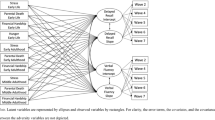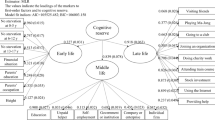Abstract
Objectives
This study aimed to explore the long-term impacts of exposure to earthquake in adolescence on later-life cognitive function in China.
Methods
Data were from the 2015 China Health and Retirement Longitudinal Study (CHARLS). Our analytical sample comprised 4394 participants aged 49 to 78 from two birth cohorts born between 1937 and 1966: exposed cohort during adolescence (born between 1952 and 1966), and non-exposed cohort during adolescence (born between 1937 and 1951). We defined earthquake exposure as the exposure severity of the 1976 Great Tangshan Earthquake (GTE). We selected community environmental characteristics as our key moderators. A difference-in-differences (DID) method was employed to estimate the long-term impact of the GTE on later-life cognitive function.
Results
We found that exposure to the earthquake during adolescence resulted in higher scores of later-life cognitive function (for males: β = 2.18; 95% CI: 0.70–3.66; for females: β = 1.22; 95% CI: 0.11–2.33). For males, this impact was moderated by community environmental characteristics including the old-age allowance program (β = 3.07; 95% CI: 1.94–4.19) and the condition of basic community infrastructures (β = 1.52; 95% CI: 0.84–2.19).
Conclusions
Our study supports the post-traumatic growth theory. This finding suggest that individuals with early-life traumatic exposure need to be focused on. Additionally, improving the conditions of community infrastructures and establishing a community environment with comfort and security may be pretty important for promoting cognitive function and post-traumatic growth.

Similar content being viewed by others

Data availability
The dataset supporting the conclusions of this article is available at https://charls.charlsdata.com/pages/Data/2015-charls-wave4/en.html.
References
McArdle JJ, Ferrer-Caja E, Hamagami F, Woodcock RW (2002) Comparative longitudinal structural analyses of the growth and decline of multiple intellectual abilities over the life span. Dev Psychol 38(1):115–142. https://doi.org/10.1037//0012-1649.38.1.115
Kuang W, Gao M, Tian L, Wan Y, Qiu P (2020) Trends in the prevalence of cognitive impairment in Chinese older adults: based on the Chinese longitudinal healthy longevity Survey cohorts from 1998 to 2014. Int Health 12(5):378–387. https://doi.org/10.1093/inthealth/ihz114
Banks J, O’Dea C, Oldfield Z (2010) Cognitive function, Numeracy and Retirement saving Trajectories*. Econ J 120(548):F381–F410. https://doi.org/10.1111/j.1468-0297.2010.02395.x
Cahn-Weiner DA, Farias ST, Julian L, Harvey DJ, Kramer JH, Reed BR et al (2007) Cognitive and neuroimaging predictors of instrumental activities of daily living. J Int Neuropsychol Soc 13(5):747–757. https://doi.org/10.1017/s1355617707070853
World Health Organization (2015) World Report on Ageing and Health. World Health Organization, Geneva
Viner RM, Ross D, Hardy R, Kuh D, Power C, Johnson A et al (2015) Life course epidemiology: recognising the importance of adolescence. J Epidemiol Commun Health 69(8):719–720. https://doi.org/10.1136/jech-2014-205300
Ben-Shlomo Y, Kuh D (2002) A life course approach to chronic disease epidemiology: conceptual models, empirical challenges and interdisciplinary perspectives. Int J Epidemiol 31(2):285–293. https://doi.org/10.1093/ije/31.2.285
Guo C, Chen G, He P, Zhang L, Zheng X (2020) Risk of cognitive impairment in children after maternal exposure to the 1998 Yangtze River flood during pregnancy: analysis of data from China’s second National Sample Survey on disability. Lancet Planet Health 4(11):E522–E9
Wang H, Stokes JE, Burr JA (2021) Depression and elevated inflammation among Chinese older adults: eight years after the 2003 SARS Epidemic. Gerontologist 61(2):273–283. https://doi.org/10.1093/geront/gnaa219
He P, Luo Y, Guo C, Chen G, Song X, Zheng X (2019) Prenatal war exposure and schizophrenia in adulthood: evidence from the sino-japanese War of 1937–1945. Soc Psychiatry Psychiatr Epidemiol 54(3):313–320. https://doi.org/10.1007/s00127-018-1584-0
Feder A, Ahmad S, Lee EJ, Morgan JE, Singh R, Smith BW et al (2013) Coping and PTSD symptoms in Pakistani earthquake survivors: purpose in life, religious coping and social support. J Affect Disord 147(1–3):156–163. https://doi.org/10.1016/j.jad.2012.10.027
Wen S, Zou H, Xu H (2021) What doesn’t kill you makes you smarter: The long-term association between exposure to epidemic and cognition. Soc Sci Med 291. https://doi.org/10.1016/j.socscimed.2021.114389
Wu Z, Xu J, Sui Y (2016) Posttraumatic stress disorder and posttraumatic growth coexistence and the risk factors in Wenchuan earthquake survivors. Psychiatry Res 237:49–54. https://doi.org/10.1016/j.psychres.2016.01.041
Tedeschi RG, Calhoun LG (2004) Posttraumatic growth: conceptual foundations and empirical evidence. Psychol Inq 15(1):1–18. https://doi.org/10.1207/s15327965pli1501_01
Ye X, He P (2022) The association between the community SARS exposure and allostatic load among Chinese older adults. J Am Geriatr Soc 70(2):352–362. https://doi.org/10.1111/jgs.17516
Guo C, He P, Song X, Zheng X (2019) Long-term effects of prenatal exposure to earthquake on adult schizophrenia. Br J Psychiatry 215(6):730–735. https://doi.org/10.1192/bjp.2019.114
Sun F-F, Wang R, Li N, Zhao X-C, Wang L, Song M et al (2019) Effects of early trauma and corticotropin-releasing factor receptor 1 gene polymorphism on adult visual spatial memory. Mol Genet Genom Med 7(12). https://doi.org/10.1002/mgg3.974
Li N, Wang Y, Zhao X, Gao Y, Song M, Yu L et al (2015) Long-term effect of early-life stress from earthquake exposure on working memory in adulthood. Neuropsychiatr Dis Treat 11:2959–2965. https://doi.org/10.2147/ndt.S88770
Luo Y, Zhang L, Pan X (2019) Neighborhood environments and cognitive decline among Middle-aged and older people in China. Journals Gerontol Ser B-Psychological Sci Social Sci 74(7):E60–E71. https://doi.org/10.1093/geronb/gbz016
Luo Y, Ye X, Wang Y, Liu Y, Liang R, He P et al (2023) Consequences of China’s special send-down movement on infectious disease control in rural areas: a natural experiment. SSM - Popul Health 23:101421. https://doi.org/10.1016/j.ssmph.2023.101421
He P, Luo YA, Guo C, Chen G, Song XM, Zheng XY (2019) Prenatal war exposure and schizophrenia in adulthood: evidence from the sino-japanese War of 1937–1945. Soc Psychiatry Psychiatr Epidemiol 54(3):313–320. https://doi.org/10.1007/s00127-018-1584-0
Athey S, Imbens GW (2006) Identification and inference in nonlinear difference-in-differences models. Econometrica 74(2):431–497. https://doi.org/10.1111/j.1468-0262.2006.00668.x
He P, Chen G, Guo C, Wen X, Song XM, Zheng XY (2018) Long-term effect of prenatal exposure to malnutrition on risk of schizophrenia in adulthood: evidence from the Chinese famine of 1959–1961. Eur Psychiatry 51:42–47. https://doi.org/10.1016/j.eurpsy.2018.01.003
Xu HW, Li LD, Zhang ZM, Liu JY (2016) Is natural experiment a cure? Re-examining the long-term health effects of China’s 1959–1961 famine. Soc Sci Med 148:110–122. https://doi.org/10.1016/j.socscimed.2015.11.028
Xu H, Zhang Z, Li L, Liu J (2018) Early life exposure to China’s 1959-61 famine and midlife cognition. Int J Epidemiol 47(1):109–120. https://doi.org/10.1093/ije/dyx222
He P, Liu L, Salas JMI, Guo C, Cheng Y, Chen G et al (2018) Prenatal malnutrition and adult cognitive impairment: a natural experiment from the 1959–1961 Chinese famine. Br J Nutr 120(2):198–203. https://doi.org/10.1017/s0007114518000958
Ye X, Zhu DW, He P (2021) The Long-Term Impact of Adversity in Adolescence on Health in Middle and older Adulthood: a natural experiment from the Chinese send-Down Movement. Am J Epidemiol 190(7):1306–1315. https://doi.org/10.1093/aje/kwab035
Chen Y, Fan ZY, Gu XM, Zhou LA (2020) Arrival of Young Talent: the send-Down Movement and Rural Education in China. Am Econ Rev 110(11):3393–3430. https://doi.org/10.1257/aer.20191414
Guo C, Zheng X (2021) Prenatal exposure to the SARS epidemic emergency and risk of cognitive impairment in toddlers. Sci Bull 66(21):2153–2156. https://doi.org/10.1016/j.scib.2021.04.011
Lee C (2014) In utero exposure to the Korean War and its long-term effects on socioeconomic and health outcomes. J Health Econ 33:76–93. https://doi.org/10.1016/j.jhealeco.2013.11.002
Casey BJ, Cannonier T, Conley MI, Cohen AO, Barch DM, Heitzeg MM et al (2018) The adolescent brain Cognitive Development (ABCD) study: imaging acquisition across 21 sites. Dev Cogn Neurosci 32:43–54. https://doi.org/10.1016/j.dcn.2018.03.001
Tang CS-k (2006) Positive and negative postdisaster psychological adjustment among adult survivors of the southeast Asian earthquake-tsunami. J Psychosom Res 61(5):699–705. https://doi.org/10.1016/j.jpsychores.2006.07.014
Stern Y (2012) Cognitive reserve in ageing and Alzheimer’s disease. Lancet Neurol 11(11):1006–1012. https://doi.org/10.1016/s1474-4422(12)70191-6
Sandanger I, Nygard JF, Sorensen T, Moum T (2004) Is women’s mental health more susceptible than men’s to the influence of surrounding stress? Soc Psychiatry Psychiatr Epidemiol 39(3):177–184. https://doi.org/10.1007/s00127-004-0728-6
Acknowledgements
Not applicable.
Funding
This work was supported by Young Elite Scientists Sponsorship Program by CAST (2022QNRC001). The funders had no role in the study design; data collection, analysis, or interpretation; in the writing of the report; or in the decision to submit the article for publication.
Author information
Authors and Affiliations
Contributions
YNL. Literature review: YL. Data curation: YL. Formal analysis: YL, YNL. Methodology: YL, YNL. Project administration: YNL. Visualization: YL. Writing–original draft: YL. Writing–review & editing: YL, YNL, XN, LZ, HH, JWZ.
Corresponding authors
Ethics declarations
Ethical approval
All procedures involving human subjects were approved by the Peking University Ethical Review Committee (IRB00001052–11015). All of the respondents involved in the study provided written informed consent before their participation in this study. All methods in this study were performed in accordance with the ethical standards laid down in the 1964 Declaration of Helsinki and its later amendments.
Competing interests
The authors have no conflicts of interest to declare for this study.
Additional information
Publisher’s Note
Springer Nature remains neutral with regard to jurisdictional claims in published maps and institutional affiliations.
Electronic supplementary material
Below is the link to the electronic supplementary material.
Rights and permissions
Springer Nature or its licensor (e.g. a society or other partner) holds exclusive rights to this article under a publishing agreement with the author(s) or other rightsholder(s); author self-archiving of the accepted manuscript version of this article is solely governed by the terms of such publishing agreement and applicable law.
About this article
Cite this article
Liu, Y., Ning, X., Zhang, L. et al. Post-traumatic growth in later-life cognitive function? Evidence from the 1976 Great Tangshan Earthquake. Soc Psychiatry Psychiatr Epidemiol (2024). https://doi.org/10.1007/s00127-024-02647-9
Received:
Accepted:
Published:
DOI: https://doi.org/10.1007/s00127-024-02647-9



